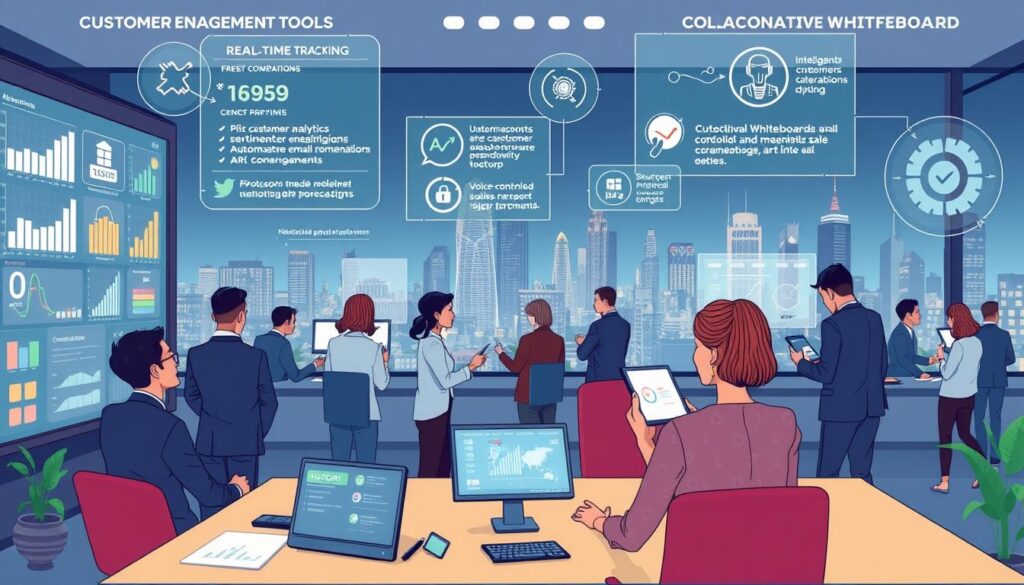Imagine running a streamlined venture from your living room that harnesses cutting-edge technology to solve real-world problems. Compact, tech-driven services are reshaping industries, allowing entrepreneurs to compete with larger players. By integrating machine learning, even small-scale operations can automate tasks, analyze data, and deliver personalized solutions.
Recent reports highlight a surge in startups using algorithms to create dynamic content, optimize digital marketing, and improve customer experiences. Over 25 innovative models have emerged, focusing on scalability and low overhead. These ventures prove you don’t need a massive team to make an impact—just the right tools.
Why are so many companies adopting these strategies? The answer lies in efficiency. Machine learning helps identify trends faster, refine search visibility, and tailor services to niche audiences. For example, one firm reduced client costs by 40% using predictive analytics.
This article explores actionable steps to build your own tech-powered service. You’ll learn how to leverage existing platforms, prioritize data-driven decisions, and scale sustainably. Let’s dive into practical ideas that turn innovation into profit.
Introduction to Micro AI Businesses
Intelligent automation is enabling solo entrepreneurs to compete in global markets. These ventures combine smart algorithms with lean operations to address specific needs—like optimizing ad campaigns or detecting cybersecurity threats. Over 60% of startups now use automated tools to reduce manual work, proving that technology isn’t just for corporations.
Understanding AI’s Impact on Small Businesses
Machine learning transforms how companies interact with clients. A local bakery, for instance, might use chatbots to handle orders 24/7, boosting response times by 70%. This shift isn’t just about efficiency—it changes what customers expect. Faster replies and personalized suggestions become the norm.
Automated systems also simplify backend tasks. Inventory management tools predict stock needs using historical data, cutting waste by up to 30%. These innovations let owners focus on growth instead of spreadsheets.
Market Opportunities in the AI Landscape
Emerging niches include fraud detection for e-commerce and dynamic pricing models for freelancers. One marketing agency increased client retention by 25% after adopting sentiment analysis tools. Such examples show how machine-driven insights create value.
The key? Continuous learning. Systems adapt as they process new data, helping businesses stay ahead. Whether refining ad targeting or streamlining customer support, scalable solutions are within reach—no office required.
Micro AI Businesses: Launch a Tiny but Mighty Service from Home
Building a tech-driven venture from home starts with identifying gaps in the market. Focus on niches where automation creates immediate value, like personalized content generation or real-time data analysis. These services often require minimal upfront investment but deliver high returns through scalability.
Key Business Ideas for Home-Based Startups
Consider offering predictive analytics for healthcare providers to forecast patient admissions. Another option: automated website audits that flag SEO issues and suggest fixes. Retailers increasingly use chatbots for inventory tracking—a perfect opportunity to sell tailored solutions.
Dynamic pricing tools for e-commerce stores also thrive. One startup helped boutique brands adjust prices based on demand, boosting profits by 18% in three months. These models work because they turn raw information into actionable insights.
Leveraging Machine Learning for Scalable Services
Use open-source frameworks like TensorFlow to build adaptive systems. Train algorithms on industry-specific data—for example, analyzing customer reviews to improve product recommendations. This way, your tool evolves as clients grow.
Partner with SaaS platforms to reach wider audiences without heavy marketing. A fitness app developer scaled to 10,000 users by integrating their AI coach into existing wellness ecosystems. Prioritize market research to refine your approach continuously.
By combining niche expertise with automated workflows, you create a self-improving service. Start small, validate with real-world data, and expand strategically. The right information pipeline turns even modest ideas into revenue streams.
Leveraging AI Tools for Business Growth
Transform your operations with smart tools that turn raw data into growth engines. Platforms like Workato One simplify integration by combining analytics, marketing automation, and team workflows into one system. This eliminates tool overload while boosting productivity.
Integrating Advanced Analytics and Marketing Automation
Start by connecting customer behavior patterns with campaign performance. Tools like Altair RapidMiner analyze social media trends and purchase histories to predict demand spikes. One e-commerce startup used this approach to reduce ad spend waste by 37%.
Automate repetitive tasks first. Chatbots handle 68% of routine customer service inquiries when trained on common scenarios. Pair them with sentiment analysis tools to escalate complex issues to your team seamlessly.
Case in point: Cylix Solutions built an AI bot that scrapes social media platforms while mimicking human browsing patterns. This helped their client gather market insights 4x faster while avoiding detection algorithms.
Use low-code platforms like Workato’s Agent Studio to build custom automations without developers. Their pre-built templates for email campaigns or inventory alerts let startups deploy solutions in hours—not months.
Finally, create a cross-functional team to oversee artificial intelligence implementation. Regular audits ensure tools align with evolving business goals while maintaining data accuracy across channels.
Innovative Strategies for AI-Driven Customer Engagement
Modern customer interactions demand precision and adaptability. Smart tools now let you craft hyper-personalized experiences that build loyalty while reducing manual effort. The key lies in merging automation with real-time insights to anticipate needs before customers voice them.

Enhancing Email Campaigns and Chatbot Interactions
Automated content creation transforms email marketing. Platforms like Typeface’s Arc analyze past campaigns to generate tailored subject lines and product suggestions. One retailer saw a 33% open-rate boost by letting AI adjust messaging based on browsing history.
Chatbots go beyond answering FAQs. They now predict issues using purchase patterns. For example, a travel agency’s bot proactively offers rebooking options when flight delays appear likely. This proactive approach reduces frustration and builds trust.
Utilizing Real-Time Data for Personalized Experiences
Dynamic platforms sync customer behavior across channels instantly. If someone abandons a cart, your system can send a personalized discount via SMS within minutes. Real-time analytics also allow users to refine ad targeting during live sales events.
Tools like Sprout Social track social media sentiment, letting you adjust campaigns mid-stream. A skincare brand used this to pivot influencer partnerships during a viral trend, boosting conversions by 28%.
Focus on strategies that learn as they operate. Test AI-driven A/B testing for emails or deploy chatbots that update responses based on seasonal trends. These methods turn fleeting interactions into lasting relationships.
Modern AI Startups and Industry Insights
The rise of nimble tech ventures is rewriting traditional business playbooks. Companies like DeepL and Moveworks prove how specialized tools can dominate niche markets. Their success stems from solving specific problems at scale—without corporate bureaucracy slowing them down.
Exploring Case Studies of Leading AI Companies
DeepL’s translation tool processes 10 billion words monthly, outperforming rivals in accuracy. By training models on technical documents and creative writing, they serve 100M+ users across industries. Similarly, Moveworks uses natural language processing to resolve 60% of IT tickets automatically—cutting response times from days to minutes.
Databricks simplified big data analysis for enterprises, helping clients like Shell reduce energy waste by 18%. These startups prioritize iterative updates based on user feedback, ensuring their solutions stay relevant.
Trends Shaping the Future of Artificial Intelligence
Real-time edge computing now powers instant email personalization. Platforms like Typeface’s Arc adjust marketing content mid-campaign using live data streams. Another shift: explainable AI frameworks build trust by showing how algorithms make decisions.
Look for tools that blend automation with human oversight. For example, OpenAI’s GPT-4 collaborates with writers to draft content while preserving brand voice. Adopt these trends by focusing on scalable solutions that evolve with your users’ needs.
No-Code Platforms to Accelerate Your AI App Launch

Launching an intelligent application no longer requires years of coding expertise. No-code platforms like Bubble and RapidAPI let you build functional prototypes in days—not months. These tools use drag-and-drop interfaces to simplify software development, letting you focus on solving problems instead of debugging code.
From Prototype to MVP with Accessible Tools
Start by validating your idea using pre-built templates. Platforms like Appy Pie offer market-ready frameworks for chatbots and analytics dashboards. One health-tech startup created a symptom-checker MVP in 11 days using Bubble’s visual editor, then tested it with 500 customers.
No-code systems slash management overhead by automating updates and integrations. RapidAPI connects your app to payment gateways and databases without manual coding. This lets you iterate based on real user feedback while maintaining a lean operation.
Integrated intelligence features refine your product as it grows. Tools like Bildr analyze user behavior to suggest interface improvements. A fitness app developer increased engagement by 40% after implementing these AI-driven insights.
When choosing platforms, prioritize scalability and third-party integrations. Look for tools offering analytics dashboards and A/B testing capabilities. With the right software, your prototype evolves into a market-ready solution faster than traditional methods allow.
Future Trends in the AI Business Landscape
The next wave of technological innovation is set to redefine how companies approach growth and customer interaction. Emerging platforms now merge predictive analytics with creative marketing strategies, enabling hyper-targeted campaigns that adapt in real time. This shift reduces time-to-market for new ideas while amplifying their impact.
Scaling Up with Emerging Technologies
Generative tools are transforming content creation by producing personalized videos and social media posts at scale. One fitness brand increased sales by 22% using AI-generated workout tutorials tailored to user preferences. These systems analyze engagement patterns to refine outputs automatically.
Real-time analytics dashboards now predict sales trends weeks in advance. Retailers use this data to adjust inventory and pricing dynamically, cutting waste by 35%. Platforms like Riverside.fm integrate AI-driven editing tools, letting teams produce podcast episodes 50% faster.
To stay competitive, adopt agile frameworks that blend traditional marketing principles with automated workflows. For example, AI-powered ad platforms test thousands of visual variants across media channels simultaneously. This approach reduces testing time from months to days while maximizing ROI.
Prioritize solutions that evolve with consumer behavior. As algorithms grow smarter, your ability to anticipate needs becomes the ultimate growth engine.
Conclusion
Today’s entrepreneurs are reshaping industries by leveraging compact, intelligent systems right from their desks. The strategies explored here—from no-code platforms to real-time analytics—prove that small-scale ventures can deliver outsized results. By focusing on niche needs and automated workflows, you create services that adapt as markets evolve.
Success hinges on collaboration. Build teams that blend technical skills with customer-centric research, and use data to guide every decision. Emerging platforms reduce entry barriers, letting you test ideas quickly while minimizing risk.
Start by crafting a clear plan that prioritizes scalability and continuous learning. Invest in tools that offer actionable insights and prioritize support systems to sustain growth. Remember, agility matters—refine your approach as you gather feedback from real users.
The road ahead brims with potential. As technology advances, so do opportunities to solve problems creatively. Stay curious, embrace iterative improvements, and let data illuminate your path forward. Your next breakthrough begins with a single step—take it today.
